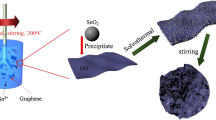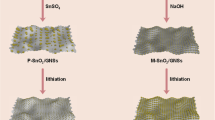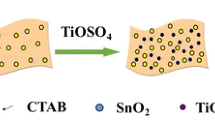Abstract
Lithium-ion batteries (LIBs) with high energy density have attracted great attention for their wide applications in electric vehicles, and the exploration of the next-generation anode materials with high theoretical capacity is highly desired. In this work, SnO2 nanoparticles with the particle size of 200 nm uniformly anchored on the surface of graphene oxide (GO) was prepared by combination of the ultrasonic method and the following calcination process. The SnO2/GO composite with the weight ratio of SnO2 to GO at 4:1 exhibits excellent electrochemical performance, which originates from the synergistic effects between GO and SnO2 nanoparticles. A high discharge capacity of 492 mA·h·g−1 can be obtained after 100 cycles at 0.2C, and after cycling at higher current densities of 1C and 2C, a discharge capacity of 641 mA·h·g−1 can be restored when the current density goes back to 0.1C. The superior electrochemical performance and simple synthesis process make it a very promising candidate as anode materials for LIBs.
Similar content being viewed by others
References
Zhu B X, Guo G N, Wu G H, et al. Preparation of dual layers N-doped carbon@mesoporous carbon@Fe3O4 nanoparticle superlattice and its application in lithium-ion battery. Journal of Alloys and Compounds, 2019, 775: 776–783
Zhang X L, Huang L W, Zeng P, et al. Hierarchical MoS2 anchored on core-shell Si@C with increased active-sites and charge transfer for superior cycling and rate capability in lithiumion batteries. Chemical Engineering Journal, 2019, 357: 625–632
Yin L, Gao Y J, Jeon I, et al. Rice-panicle-like γ-Fe2O3@C nanofibers as high-rate anodes for superior lithium-ion batteries. Chemical Engineering Journal, 2019, 356: 60–68
Yang Y C, Huang X Y, Xiang Y, et al. Mn3O4 with different morphologies tuned through one-step electrochemical method for high-performance lithium-ion batteries anode. Journal of Alloys and Compounds, 2019, 771: 335–342
Xia M, Zhou Z, Su Y F, et al. Scalable synthesis SiO@C anode by fluidization thermal chemical vapor deposition in fluidized bed reactor for high-energy lithium-ion battery. Applied Surface Science, 2019, 467–468: 298–308
Chang P Y, Doong R A. Microwave-assisted synthesis of SnO2/mesoporous carbon core-satellite microspheres as anode material for high-rate lithium ion batteries. Journal of Alloys and Compounds, 2019, 775: 214–224
Zhang Q, Gao Q M, Qian W W, et al. Porous A-SnO2/rGO nanocomposite via annealing treatment with stable high-capacity as anode of lithium-ion battery. ChemistrySelect, 2018, 3(16): 4303–4309
Chen L C, Ma X H, Wang M Z, et al. Hierarchical porous SnO2/reduced graphene oxide composites for high-performance lithiumion battery anodes. Electrochimica Acta, 2016, 215: 42–49
Wang J J, Wang L Y, Zhang S Y, et al. Facile synthesis of iron-doped SnO2/reduced graphene oxide composite as high-performance anode material for lithium-ion batteries. Journal of Alloys and Compounds, 2018, 748: 1013–1021
Zuo S Y, Wu Z G, Li S K, et al. High rate performance SnO2 based three-dimensional graphene composite electrode for lithium-ion battery applications. RSC Advances, 2017, 7(29): 18054–18059
Zhang J, Tian M Y, Zou Y L, et al. Nanostructural fibroid TiO2/SnO2 composites as anode materials for lithium-ion batteries. Nanoscience and Nanotechnology Letters, 2017, 9(7): 998–1002
Zhang F, Yang C, Gao X, et al. SnO2@PANI core-shell nanorod arrays on 3D graphite foam: a high-performance integrated electrode for lithium-ion batteries. ACS Applied Materials & Interfaces, 2017, 9(11): 9620–9629
Yi L G, Liu L, Guo G X, et al. Expanded graphite@SnO2@polyaniline composite with enhanced performance as anode materials for lithium ion batteries. Electrochimica Acta, 2017, 240: 63–71
Chen W H, Song K M, Mi L W, et al. Synergistic effect induced ultrafine SnO2/graphene nanocomposite as an advanced lithium/sodium-ion batteries anode. Journal of Materials Chemistry A: Materials for Energy and Sustainability, 2017, 5(20): 10027–10038
Ao X, Jiang J J, Ruan Y J, et al. Honeycomb-inspired design of ultrafine SnO2@C nanospheres embedded in carbon film as anode materials for high performance lithium- and sodium-ion battery. Journal of Power Sources, 2017, 359: 340–348
Liu R P, Su W M, Shen C, et al. Hydrothermal synthesis of hollow SnO2 spheres with excellent electrochemical performance for anodes in lithium ion batteries. Materials Research Bulletin, 2017, 96: 443–448
Liu R P, Su W M, He P, et al. Synthesis of SnO2/Sn hybrid hollow spheres as high performance anode materials for lithium ion battery. Journal of Alloys and Compounds, 2016, 688: 908–913
Chai X H, Shi C S, Liu E Z, et al. Hierarchically structured carboncoated SnO2-Fe3O4 microparticles with enhanced lithium storage performance. Applied Surface Science, 2016, 361: 1–10
Lian P C, Wang J Y, Cai D D, et al. Porous SnO2@C/graphene nanocomposite with 3D carbon conductive network as a superior anode material for lithium-ion batteries. Electrochimica Acta, 2014, 116: 103–110
Chen J S, Lou X W. SnO2-based nanomaterials: synthesis and application in lithium-ion batteries. Small, 2013, 9(11): 1877–1893
Chen S, Xin Y L, Zhou Y Y, et al. Branched CNT@SnO2 nanorods@carbon hierarchical heterostructures for lithium ion batteries with high reversibility and rate capability. Journal of Materials Chemistry A: Materials for Energy and Sustainability, 2014, 2(37): 15582–15589
Acknowledgements
The authors acknowledge the financial support from the Natural Science Foundation of Beijing (No. 2162037 and L182062), the Beijing Nova Program (Z171100001117077) and the Yue Qi Young Scholar Project of China University of Mining & Technology (Beijing) (No. 2017QN17).
Author information
Authors and Affiliations
Corresponding author
Rights and permissions
About this article
Cite this article
Liu, R., Zhang, N., Wang, X. et al. SnO2 nanoparticles anchored on graphene oxide as advanced anode materials for high-performance lithium-ion batteries. Front. Mater. Sci. 13, 186–192 (2019). https://doi.org/10.1007/s11706-019-0463-2
Received:
Accepted:
Published:
Issue Date:
DOI: https://doi.org/10.1007/s11706-019-0463-2




